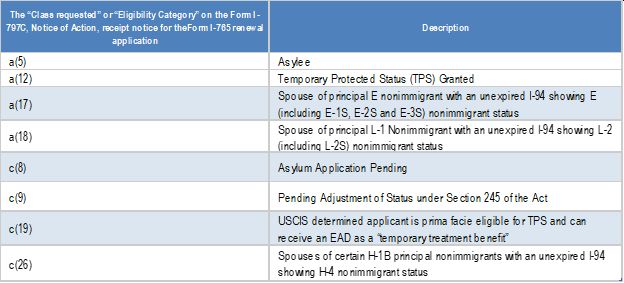- within Immigration topic(s)
- with readers working within the Business & Consumer Services, Retail & Leisure and Construction & Engineering industries
- within Compliance, Consumer Protection, Government and Public Sector topic(s)
The Department of Homeland Security (DHS) announced a permanent increase in the automatic extension period for certain Employment Authorization Documents (EADs) up to 540 days. The final rule will take effect on January 13, 2025.
Background on the History of Automatic EAD Extensions
The automatic extension of EADs was first introduced in 2016 to address extended processing times, which led to gaps in employment. Prior to the automatic extension, an employee could only continue working if they had the approved EAD extension physically in hand. Initially, the automatic extension period was for up to 180 days (or the eligible validity of the work authorization, whichever was shorter). However, additional backlogs – created by the COVID-19 pandemic and significant increases in EAD application filings – led to officers being unable to adjudicate EAD extensions even within the 180-day window.
DHS issued two updates in 2022 and 2024, each temporarily extending the increase of the automatic extension period to up to 540 days. These extensions helped to mitigate lapses in employment authorization and provided USCIS with an opportunity to catch up on processing backlogs and adjudication delays without negatively impacting the EAD applicants and, by extension, their employers.
Eligible EAD Categories
Not all EAD categories are eligible for an automatic extension. DACA recipients c(33) do not benefit from this rule, and STEM c(3)(C) applicants are still only eligible for a 180-day extension. The below is a list of the most common categories that are eligible for the 540-day automatic extension with a timely filed application:

The full list of eligible categories can be found here.
Other Requirements
The auto extension applies to employees who timely filed Form I-765, Application for Employment Authorization, for EAD renewals in the same eligibility category as the employee's Form I-797C, Notice of Action, issued for the corresponding EAD renewal application. USCIS has confirmed that "the extension begins on the "Card Expires" date on face of their EAD and generally continues for up to 540 days as applicable, or until USCIS denies the renewal application, whichever comes earliest."
Impact for Employers
The increased extension period all but eliminates the risk of eligible employees losing work authorization simply due to government processing backlogs, negatively impacting business operations. A permanent automatic extension period now also simplifies compliance with I-9 employment verification requirements. Employers can be more confident in their ability to maintain a legally authorized workforce, reducing the risk of penalties for employing unauthorized workers.
According to the USCIS, the I-9 should be completed as follows for a new hire presenting an EAD that has been automatically extended:
Section 1.
Employee should select "A noncitizen authorized to work until;" and
Enter the date that is 540 days from the "Card Expires" date on the EAD as the expiration date of employment authorization. Employees whose status does not expire, such as refugees or asylees, should enter "N/A" as the expiration date.
Section 2.
Employer should enter "EAD" in the Document Title field in the List A column.
Enter the Card Number from the EAD in the Document Number field.
In the Expiration Date field, enter the date 540 days from the "Card Expires" date on the EAD if the "Received Date" on Form I-797C is between May 4, 2022, and Sept. 30, 2025.
For automatic extensions, the employer should enter "EAD EXT" in the Additional Information field. Electronic I-9 systems should assist with automatic extensions calculations or you may use the EAD Automatic Extension Calculator to determine extended expiration dates.
It is important that employers recognize the expired card and I-797C combination serve as an automatically extended EAD. This is NOT a receipt and should be recorded as a List A EAD document.
For further guidance on completing Form I-9 covering automatic extensions, including for existing employee, and proof of employment authorization for hiring, rehiring, and reverification, as well as all other Form I-9-related guidance, please visit I-9 Central or see Section 5.1 of the M-274.
The content of this article is intended to provide a general guide to the subject matter. Specialist advice should be sought about your specific circumstances.



